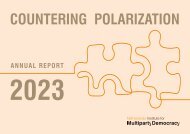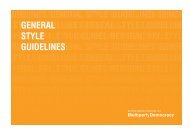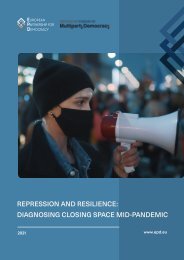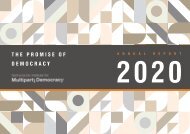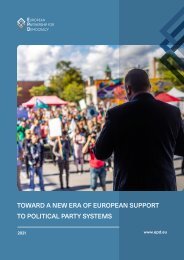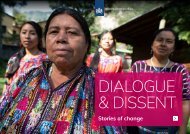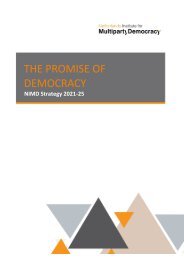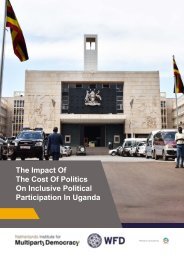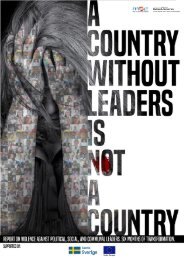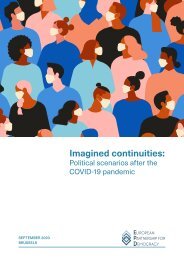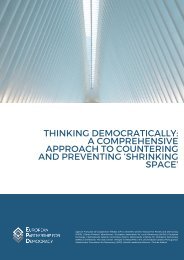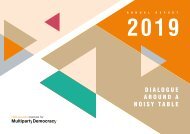Political Party Guidelines Eng
Create successful ePaper yourself
Turn your PDF publications into a flip-book with our unique Google optimized e-Paper software.
Example: Philippines and gender responsive budgeting
Stages of budget cycle where GRB adopted: formulation, legislation, implementation and audit/review
Main driver/leader: Philippine Commission on Women (PCW)
Success factors: strong institutional framework; capacity-building of government and non-government
entities; monitoring and accountability mechanism
1. Context: Philippines has been engaged in gender-responsive budgeting, at the national and local
levels, for over two decades.
The current Gender and Development (GAD) Budget Policy has evolved from a series of legislative mandates,
including the Magna Carta of Women (1999) which requires all government agencies to allocate
at least five percent of their budgets to address gender issues - with the intention for the five per cent to
influence the remaining 95 per cent.
2. Implementation: Government agencies are required to produce a GAD plan and budget, as well as a
report, on an annual basis. Technical support and capacity-building assistance is provided to agencies
by the PCW through training, workshops, advisory services and written guidelines. Aside from the PCW,
oversight agencies for the implementation of the GAD Budget Policy include the Department of Budget
and Management; Department of the Interior and Local Government; National Economic and Development
Authority; and Commission on Audit.
One unique feature of GRB in Philippines is the implementation of gender audits as part of the mainstream
audit processes, accompanied by strict measures for non-compliance.
Philippines has also taken steps to promote GRB at the sub-national level, including through the provision
of technical assistance in conducting gender analysis of the socioeconomic situations of Local Government
Units (LGUs) and integrating sex-disaggregated data into local planning and budgeting.
3. Results and challenges: Increased compliance and submission of the annual GAD Plan and Budget;
institutionalization of the GAD Focal Point System in agencies and LGUs; increased attribution of regular
programmes to the GAD Plan and Budget; mainstreaming of the GAD perspective in formulation and implementation
of agency plans and programmes; and an increase in the number of top level champions
on GAD, both at the national and local levels.
However, critical challenges also remain, including uneven level of capacities of GAD focal points and
project implementers in mainstreaming GAD perspectives; lack of effective tracking of GAD spending;
assignment of Focal Point positions to mostly women staff as GAD is considered “for women” only; and
low GAD budget utilization since gender equality is not a priority agenda for critical agencies and local
chief executives.
4. Lessons learned and the way forward: GRB in Philippines has enabled considerable advances in
ensuring programmes, projects and activities are more gender-responsive. However, most agencies continue
to focus on the five per cent of the GAD budget, rather than the remaining 95 per cent. Therefore,
further efforts are particularly required in enhancing the understanding of gender mainstreaming principles
amongst government officials.
14
GUIDELINES FOR POLITICAL PARTIES IN MYANMAR




